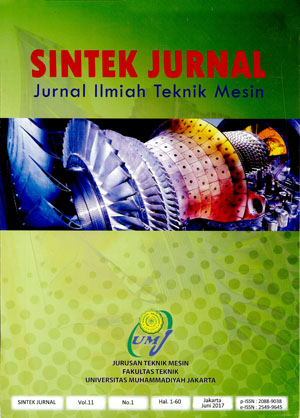ANALISIS TINGKAT KEMATANGAN INDUSTRI KOMPONEN OTOMOTIF DI INDONESIA
Main Article Content
Abstract
The main purpose of this paper is to obtain a portrait of the level of maturity (maturity level) automotive component industry in Indonesia. With the completion of the level of maturity of industry ritating component parts can be recommended treatment is needed for each industry based on the level. In accordance with the objectives to be achieved, the scope of this activity is only focused on a rotating component wheel vehicle part 4 (four). The conceptual development stages of maturity level models (maturity level) automotive components industry, which are as follows: Desk review, collection and development of data using secondary data is required, Collection and selection of manufacturing industry maturity model framework, Preparation checklist or questionnaire, Implementation of the framework was elected in selected automotive components industry and Do the processing, calculation and analysis of data with the approach of maturity models. The result of this paper is Indonesia's automotive component industry has the potential to be developed and reliable, and can be one of the competitive component suppliers in vehicle production in ASEAN. However, existing capabilities must be improved.
Article Details
How to Cite
[1]
F. Hendra, “ANALISIS TINGKAT KEMATANGAN INDUSTRI KOMPONEN OTOMOTIF DI INDONESIA”, sintek. jurnal. ilm. teknik. mesin, vol. 11, no. 1, pp. 38–48, Jun. 2017.
Section
Articles
- Articles published in SINTEK JURNAL are licensed under a Creative Commons Attribution-ShareAlike 4.0 International license. You are free to copy, transform, or redistribute articles for any lawful purpose in any medium, provided you give appropriate credit to the original author(s) and SINTEK JURNAL, link to the license, indicate if changes were made, and redistribute any derivative work under the same license.
- Copyright on articles is retained by the respective author(s), without restrictions. A non-exclusive license is granted to SINTEK JURNAL to publish the article and identify itself as its original publisher, along with the commercial right to include the article in a hardcopy issue for sale to libraries and individuals.
- By publishing in SINTEK JURNAL, authors grant any third party the right to use their article to the extent provided by the Creative Commons Attribution-ShareAlike 4.0 International license.
References
Humphrey, W. S. (March 1988). "Characterizing the software process: A maturity framework" (PDF). IEEE Software 5 (2): 73–79. doi:10.1109/52.2014.
Paulk, Mark C.; Weber, Charles V; Curtis, Bill; Chrissis, Mary Beth (February 1993). "Capability Maturity Model for Software (Version 1.1)"
T. Mettler (2010), Thinking In Terms Of Design Decisions When Developing Maturity Models, International Journal of Strategic Decision Sciences, 1.
T. Mettler, P. Rohner, and R. Winter (2010), Towards a Classification of Maturity Models in Information Systems, Management of the Interconnected World, in: A. D'Atri, M. De Marco, A.M. Braccini, and F. Cabiddu (Eds.), Berlin, Heidelberg: Physica.


